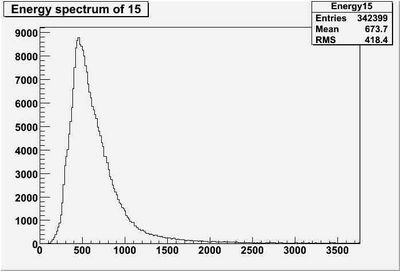Difference between revisions of "CDC 09 04 2008"
m (→More analysis of cosmic data) |
m (→125 MHz Clock test) |
||
| Line 4: | Line 4: | ||
| + | Everything is set up to run with the external clock. | ||
=== Change incident angle === | === Change incident angle === | ||
Revision as of 17:11, 8 April 2008
125 MHz Clock test
A scope trace can say more than a 1000 words:
Everything is set up to run with the external clock.
Change incident angle
Before we had the two scintillators positioned one above the other. In this way we selected cosmic rays with an incident angle of 90 degrees (compared to the straws). The upper scintillator is placed on the other end of the CDC: 2m away (in z) from the other scintillator. Before we had a rate of 0.65 Hz. I calculated the incident angle to be 17 degrees, which means that we expect a rate of 0.0556 Hz. We see a rate of 0.0767 Hz - that would mean a average incident angle of 20 degrees. I will take data till the new cable arrives (Wednesday) and then analyze the data and compare with previous situation.
FYI: we could tilt the chamber to any angle we want - we just have to be careful.
FADC timing
More analysis of cosmic data
The preAmp is not at Carnegie Mellon University - so I have some time to do some more analysis. I will always show two figures, on the left side is always with the cosmic rays at 90 degrees, the right side has the cosmic rays at 20 degrees (on average).
Let's start with the raw energy spectrum of straw 15
Everything below 1750 ADC channels is considered low energy noise and is therefore cut away. The resulting energy spectra are in figure 2a+b.




